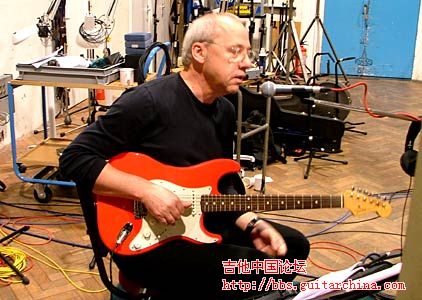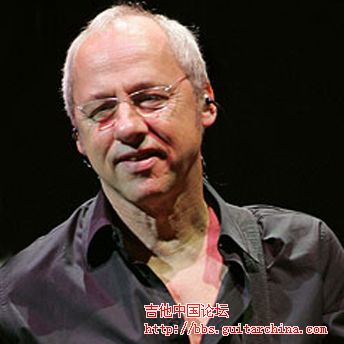版主
UID88473
好友
回帖0
主题
精华
积分114106
阅读权限255
注册时间2004-5-6
最后登录1970-1-1
在线时间 小时
|
MARK KNOPFLER 是我多年来的偶像,给喜欢他的人介绍一个论坛:
http://www.freewings.cn/discuz!/forum-40-1.html
北京的网友ALLEN是他的非常FANS,一直致力于MK的资料,信息,新闻等等的收集,在此向各位推荐一下,并向ALLEN致敬。
顺转一篇文章:
[资料] Mark Knopfler 1978-1996 吉他音色资料(包括吉他和效果器)
1978/79
Rumours say that an Dan Armstrong Orange Squeezer (compressor) and an Aphex Exciter were used on album one. Obviously compression was used frequently on album one and Communiqué. The engineer of album one, Rhett Davies, "was in love with Roland Chorus devices". You can hear Chorus on Lions, and slightly on some of the other songs.
Live he played a Morley Volume pedal and a MXR analog delay (green box). The Morley was used to create the violin sound, f.e. in the intro of Lions or in News.
Nady guitar transmitter (from second half of 1979 on)
some notes about sound:
The Morley changes the tone even when it is full way down, due to its 66K input impedance. It makes a Strat sound smoother, less harsh, because the resistance dampens the frequency peak of the pick up.
The MXR delay has an unique bypass, which means when it is switched off, it does not convert the impedance of the guitar signal, like nearly all other effect boxes do, even when switched off. This means that the capacity of the cable between effect and amp influences the signal of the guitar (all cables do, compare the sound with an extreme short ( = low capacity) and a long ( = high capacity)cable !!). The more capacity a cable has, the more it shifts down the frequency peak of a pick up. With a cable of only some centimetres this peak is about 6kHz, with long cables (total length of all cables before and after the effect boxes) it is easily down to 2 - 3kHz, which gives you a much darker sound.
Usually the capacity of the cable behind an effect box does not play a role, but with the MXR it does. This is why the guitar sound on live recordings from this period is much darker than on the studio versions.
When Mark started to use a guitar transmitter in late 1979, this again had an effect on the sound. As you have only a very short cable between guitar and transmitter, the frequency peak is much higher. As the receiver converts the signal to low impedance, the length of the following cables does not matter. This is why the sound on recordings from late 1979 (on the CD live in Boston or on the Arena BBC documentary) is much brighter again.
1980/81
Customized rack comprising:
Deltalab Delay Unit
Flanger
Master R Reverb
Roland Equalizer
Mantec Switch Unit
Roland Choms Echo
Mantec Preamp
2 Main Transformers
Morley Volume Pedal
Mantec Remote Switching Unit
Nady guitar transmitter
1985/86
Custom rack including:
Roland SRE 555 Chorus/Echo
Delt Lab Digital Delay
Mic-Mix Dyna-Flanger
Master Room Reverb Unit
Roland Graphic EQ
Ibanez UE 303 Multi Effect
a variety of Boss pedals, including:
CE 300 Chorus
DM 2 Delay
CS 2 Compressor
two CE 2 Chorus
BF 2 Flanger
PH 2 Phaser
OC 2 Octaver
1991/92
Custom system build by Pete Cornish, including:
TC 2290 Delay
Alesis Quadraverb
Boss Super Chorus CE 300
Zoom Multieffect 9010
Yamaha REV 5 (reverb)
two TC-Equalizers/Preamps (for the National and Ramirez guitars)
Wah Wah (Money for Nothing), integrated into the rack system
click here to see the usage of these effects (settings of amps and effects)
Earney Ball Volume Pedal
Sony Wireless system
1996
Ron Eve:
"When Mark and I discussed what equipment he would be using for the tour, we decided that although the Crate Vintage 50w combo amp had served exceptionally well in the studio, operationally there would be problems on stage. There was no way to smoothly and quickly change guitars and set up new sounds for each song, even using two combos. So Mark decided to use a cut-down version of the set-up from the last Dire Straits tour (On Every Street). He wanted to use the two Soldano 100 Lead heads but without the Marshall/EV speaker cabinets and Pete Cornish effects rack. He was keen to try using 2 x 12 cabinets, again with EV speakers and a simple FX set-up comprising "some expensive delay and reverb..." and a footswitch. The final arrangement consisted of an Ernie Ball volume pedal, Active Lead, 2 Soldano amp heads (alternating A/B), 2 Hughes & Kettner 2 x 12 cabinets (loaded with EV's), TC2290 delay unit, Lexicon 300 reverb unit, MXR micro amp and a TC 0144 footswitch.
The Crate combos will be used for back-up. The TC 2290 was used as the main controller and MIDI'd to the Lexicon, with the Lexicon patched through one of the loops; the MXR was hooked through another loop, to provide a clean boost and a footswitch assigned to toggle it in/out. Another switch was assigned to toggle the repeat (delay) on/off. As rehearsals progressed, patches containing each songs' effects set-up were assigned to various presets (switchable from the TC0144). Tone settings for each song were set up on the Soldanos with the aim of switching amps between each song. Fast segues between songs can be accomodated in this way." |
-

-

|
